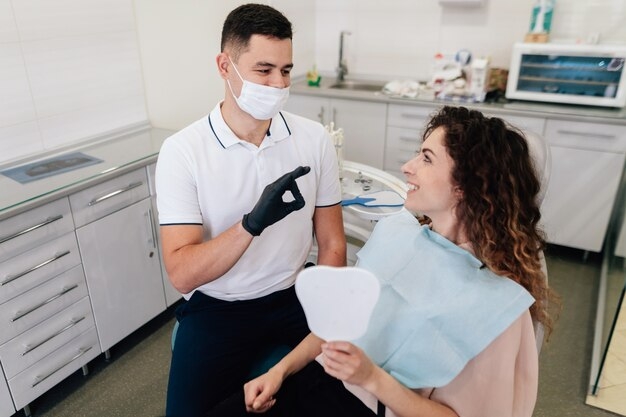
Essential Tips for Lifelong Oral Health
Taking care of your teeth and gums is crucial for maintaining a healthy smile throughout your life. Good oral hygiene not only keeps your teeth looking great but also significantly lowers the risk of tooth decay and gum disease.
Key Steps for Oral Care
To ensure your teeth and gums stay in excellent shape, follow these five essential steps:
- Brushing
- Flossing
- Rinsing
- Eating a balanced diet
- Regular dental visits
Understanding Gum Disease

Gum disease begins when plaque—a sticky film of bacteria—builds up under the gum line. This can lead to infections affecting your gums and bone. Gingivitis is the earliest stage and causes your gums to become:
- Inflamed
- Tender
- Red
- Swollen
- Prone to bleeding
Luckily, gingivitis is reversible with timely treatment. If left untreated, it can advance to periodontitis, which affects the bone supporting your teeth and can eventually lead to tooth loss. The most severe stage, advanced periodontitis, destroys the supporting tissues and bone, possibly affecting your bite and requiring tooth extraction.
Recognizing the Signs of Gum Disease
According to the American Dental Association (ADA), you might have gum disease if you notice:
- Persistent bad breath or a bad taste in your mouth
- Loose or separating teeth
- Gums that bleed easily
- Swollen, red, or tender gums
- Gums pulling away from your teeth
Preventing Gum Disease
- Floss Daily: Flossing helps remove plaque and food particles from between your teeth. Do it daily, at any time that fits your routine.
- Get Regular Cleanings: Routine cleanings allow your dentist to catch early signs of gum disease and remove tartar that brushing and flossing miss.
- Quit Smoking: Smoking is linked to gum disease and weakens your immune system, making it harder to fight infections and heal gums.
- Brush Twice a Day: Brush after meals to remove food and plaque. An electric toothbrush can be more effective than a manual one. Replace your toothbrush or head every three to four months.
- Use Fluoride Toothpaste: Opt for fluoride toothpaste with the ADA seal to protect against gingivitis and decay.
- Use Therapeutic Mouthwash: Therapeutic mouthwashes can reduce plaque and prevent gingivitis. Look for the ADA seal for safety and effectiveness.
Brushing Your Teeth and Gums

Brushing is a vital part of your daily oral care routine. Aim to brush at least twice a day, and ideally about 30 minutes to 1 hour after meals. Here’s a simple guide to brushing effectively:
- Use a pea-sized amount of fluoride toothpaste on a soft-bristled toothbrush.
- Hold the brush at a 45-degree angle to your gum line.
- Brush each tooth with small, circular motions. If you use an electric toothbrush, keep it at the same angle and let it do the work. Don’t press too hard—only the tips of the bristles should touch your teeth.
- Brush the chewing surfaces of your back teeth thoroughly.
- Clean the back sides of your teeth using the same circular motion.
- For the inside of your bottom front teeth, tilt the brush up and down and move in small circles. For the top front teeth, angle the brush with the tip facing the roof of your mouth.
- Gently brush your tongue to help remove bacteria and freshen your breath.
- Rinse your mouth with mouthwash after brushing.
- Replace your toothbrush every three to four months.
Flossing Your Teeth
Flossing helps get rid of plaque and food particles between your teeth that your toothbrush can’t reach. Aim to floss at least once a day, preferably after meals. Here’s how to do it right:
- Cut an 18-inch piece of floss.
- Wrap the ends around your middle fingers, leaving about 1 inch of floss to work with.
- Use your index fingers to guide the floss between your teeth gently.
- Move the floss up and down and curve it around the gum line to remove plaque.
- Floss between each tooth and behind the back teeth, using a fresh section of floss as needed.
Rinsing Your Teeth and Gums
Mouthwash is an important part of your oral care routine. Choose an antiseptic mouthwash to kill bacteria or a fluoride mouthwash to help prevent decay. Here’s how to use it effectively:
- Swish the mouthwash around your mouth for 30 to 60 seconds.
- Use mouthwash either before or after brushing and flossing.
Diet and Dental Health
What you eat plays a significant role in your dental health. Try to maintain a balanced diet and avoid foods high in sugars and starches. These foods produce acids that can damage your teeth. Be cautious with:
- Hard candies
- Sugary gum
- Chips and crackers
- Dried fruits and raisins
Snacking on sugary or starchy foods can lead to tooth decay, especially if you don’t brush afterward.
Routine Dental Visits

Regular visits to your dentist are essential for keeping your teeth and gums healthy. Aim for at least two check-ups per year. These visits help catch and address issues early, and professional cleanings remove tartar and plaque that brushing and flossing might miss. If you have tooth pain, bleeding gums, or swelling, see your dentist promptly.
Ask about dental sealants, which can protect the chewing surfaces of your back teeth from decay.
By consistently brushing, flossing, and rinsing, and using the right products, you can maintain excellent oral health and keep your smile bright.




